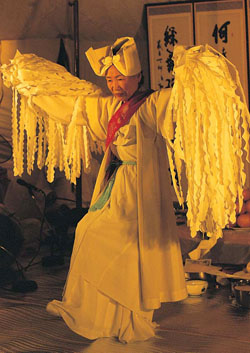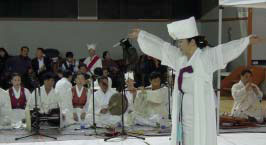진도 씻김굿
Traditional Ritual Ceremony as a Festival,
Jindo Ssitgimgut
By Jeong Ha-na, Tribune Reporter

In addition, many of them consider it is not a good custom these days. But, that is not all of gut. We have a bias against it though there is another aspect we do not know about. Let us see what the value of gut is and understand it correctly through Ssitgimgut which is a well known gut. People living in Jindo enjoy this ceremony as a festival and an invaluable tradition.
The Types and Distinctiveness of Jindo Ssitgimgut
Jindo Ssitgimgut was made since it cleans the grudges of the dead against this world and was designated as Important Intangible Cultural Property 72 in November, 1980. Ssitgimgut is a form of exorcism praying for Geukrakwangsaeng (the gentle and easy passage to heaven) influenced by its Buddhist nature originated in the Goryeo Kingdom. The sort of Jindo Ssitgimgut is various depending on its purpose. Gwakmeoriessitgimgut is performed right next to the corpse during the funeral and Sosangssitgimgut is performed in the first anniversary of the death and we also call it Talsangssitgimgut.
When one of the family members is sick or misfortunes too often happen to them, Nalbajissitgimgut is performed to appease the ancestor’s anger because they believe that bad things come from their mistakes to them. There are also performances of marriage for the dead virgin and bachelor, and appreciation for ancestors about a happy event. Ultimately, Ssitgimgut is for the harmony of relationship between the dead and the living, and respect for their ancestors.

Jimoo shows a more limited and artistic gut in Mooak (playing musical instruments) and Mooga (to sing songs) than Gangsinmoo does. A band of Moodak is usually composed of various string and wind instruments, including Piri (flute), Janggu (double-headed drum), Buk (drum), Haegeum (Korean fiddle) and Ajaeng (seven-stringed instrument). The players called as Goak or Aksa are mostly males while the exorcists are females. These characteristics are the reason why it is shown on many stages as a folk art and why it is famous to the public. In addition, Jimoo wears a white dress and a white hat resembling the Buddhist priest’s robe while Gangsinmoo wears colorful costumes.
As the cleansing exorcism, Ssitgimgut, has many courses and is performed according to its procedure. To explain it shortly, without too many details, the first step of informing the purpose of gut is Andang and calling a soul of the dead and invites the souls of its ancestors is Chogamangseok. Secondly, Cheoolrigi is an exorcist that entertains the invited souls and comforts them by untying the knot, 'Go' symbolizing their 'Han' (the grudge and spite of the dead) is Gopili.
And the central point of gut is Iseulteolgi that is to clean the corpse or a thing substituting the dead (called Yeongdon) with clean water brewed with green tea to help the souls go to heaven and pacify them. Finally, she cleans the road to heaven bidding farewell to the souls of the dead and this step is Gildakeum. During the ceremony, she sings Samjangaebi which has fluctuating melodies creating tunes with her peaceful vocal techniques and captaining prayers for them. So this song evokes people’s tears.
Gut as a Festival

I arrived there early and had a look around the place and people preparing for the performance. There was his family, and pupils of Ssitgimgut Preservation and students majored in Korea Traditional Performing Art in DaeBul University, where he was a chair-professor. They helped each other for the ceremony by preparing food sincerely, installing the electronic system busily and wearing the white dress for gut. Although the weather was rainy and cold, all of the people looked joyful and happy. I felt very strange as I thought they have to feel sad and gloomy. I asked Jimoo (an exorcist) why they looked happy.
She said, "Actually, the ritual ceremony, gut, is not a sad thing because we could meet the soul of the dead through it and also feel comfortable during and after it. We just consider it as a festival. In addition, Park's daughter became a Jimoo today, so it is a double pleasure. Enjoy the gut." As she said, people enjoyed that moment and happily shared foods and drinks at all times during the performance. Even if all of them were not his family members, they seemed very familiar and saw the Ssitgimgut performance in the happy mood. It looked good.
When the performers including an exorcist, instrument players and a host finished their preparation, they started the Ssitgimgut by introducing the late Park Byeong-cheon, and then his family bowed politely. Jimoo sat down in front of the picture of the dead and recited the incantation to the accompaniment of a band. That step was Chogamangseok to invite the soul. Many people saw the gut eating food and pouring Makgeolli (rice wine) to each other. And also, there were many reporters and students who are interested in or majored in Ssitgimgut and wanted to report about it.

That sight showed the great fame of Ssitgimgut and the fact that there were many people to preserve this local culture. The Jimoo danced intensely grasping Yeongdon (symbol of the dead) to entertain the soul. There were other performances, Pansori and Janggu danced by his pupils for a little time between several steps of the ceremony. It was impressive that the people directly took part in gut together by lifting up a long white cloth to put money for the soul to spend it during going to the heaven.
Seeing and feeling the ceremony, I thought that I had wrong thoughts about gut and it is a very precious cultural asset to show our traditional emotion 'Han'. Also, it was not scary as the general population knows. It is a festival! It was very regrettable that I could not see all performances and entertainment after the ceremony. As there will be an event every year and many stages in other festivals and the public performances, I will have an opportunity to see all of the ceremonies and feel Ssitgimgut again.
Gut Is Good
Before the performance, I read a book entitled “Gut is Good” introducing gut as a unique part of Korean culture. Yes, I feel so too. It is an amazing ceremony. We have to consider it as a source of pride in Korea. In addition, South Jeolla Province pursues UNESCO designation for shamanist rites as Masterpieces of the Oral and Intangible Heritage of Humanity to inform its value to the world and preserve it. The current practice of hereditary transmission of shamanist practices by region has not yet been fully researched.
We need real efforts at preservation and research. Not only is a few, but also the public organizations’ interest in our cultural properties are very important. Try to be familiar with gut and throw away our old prejudice about it. The best way to keep our culture is to know it correctly. After this chance, this reporter changed her thoughts of gut. Now, I want to say, “Gut is good!”

